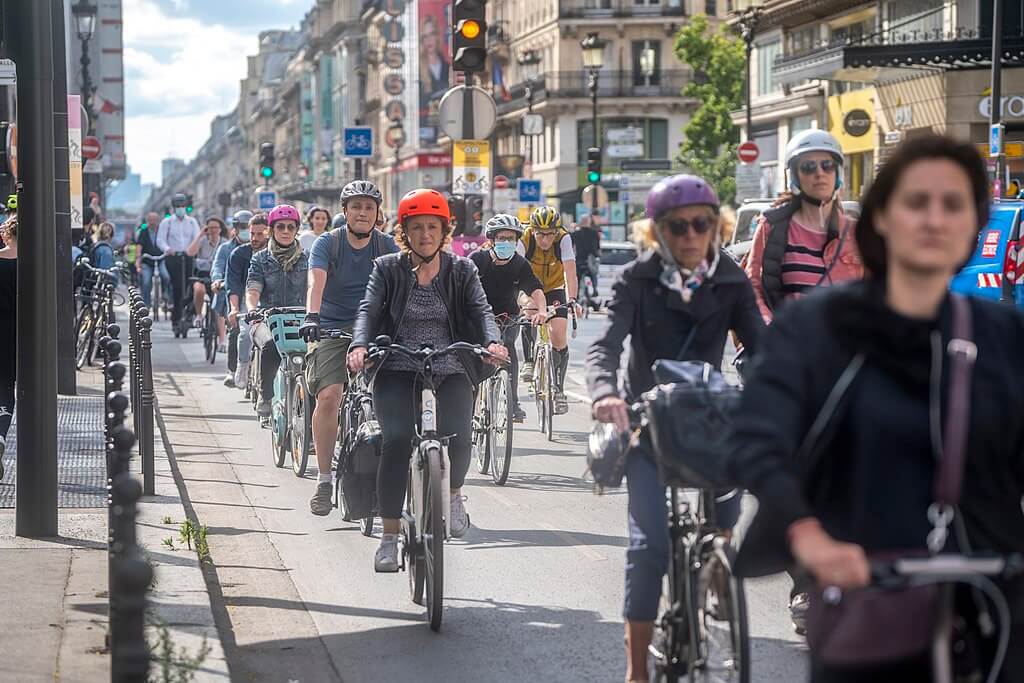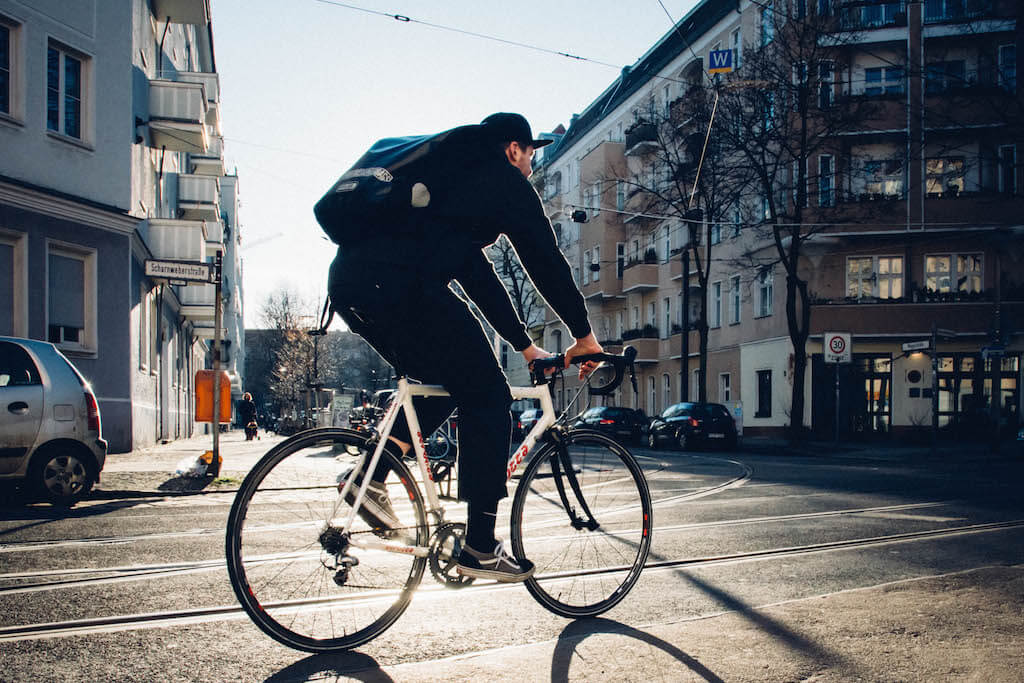Autumn Gear Guide
Find inspiration in our Gear Guide that will keep you out on your bike through wind or rain.
Download NowA funny thing happened on the way to impending doom over the climate crisis, people started to realize that a simple old-timey two-wheeled machine of grand design could be a major part of the solution. Yes, the humble bicycle. Now, cities across Europe are taking bold steps to reduce their carbon footprint and create more […]
A funny thing happened on the way to impending doom over the climate crisis, people started to realize that a simple old-timey two-wheeled machine of grand design could be a major part of the solution. Yes, the humble bicycle. Now, cities across Europe are taking bold steps to reduce their carbon footprint and create more active transportation options for their citizens by making cycling a focus. A safe and secure bicycle network can impact not only personal transportation choices but also on the business side how goods are moved around cities, which is a game-changer. But this will not happen without a clearly defined, safe, and secure network of cycling infrastructure.
To facilitate the growth of this clean and green transportation machine, one of the most significant trends in recent years has been removing street parking spaces for cars to create more space for bicycles (and pedestrians).
In North America, every street parking space leads to lengthy and sometimes fiery debates as bike lanes aren’t linked to any specific greater issue. With active and sustainable transportation linked to climate targets and a collective effort to reduce greenhouse gas emissions in the transportation sector, there is an added focus on bicycles in Europe. Many cities in Canada and the United States are moving in the right direction and doing great things, but linking to this great threat we all face would only add to the momentum. Yes, I said it, momentum.
Here are five major European cities that are leading the way in this transformational change.
Barcelona is one of Europe’s most vibrant and bustling cities, but it has also been grappling with issues of congestion and pollution. In response, the city has been working to reclaim its streets from cars and prioritize sustainable transportation options. The Barcelona Superblock Program is an urban development initiative launched by the city of Barcelona in 2016. The program aims to create large pedestrian-friendly areas by transforming sections of the city into “superblocks,” taking one of every three streets and turning it into a “garden street.” The superblocks are designed to prioritize walking, cycling, and public transportation over cars, reducing traffic congestion and air pollution while promoting sustainable modes of transportation. Thousands of parking spaces have been ripped up as a result of the ambitious project.
Paris has long been a leader in sustainable transportation, and the city is taking further steps to reduce its carbon footprint. The city is removing 70,000 parking spaces, representing half of all such spaces in the city. In their place, the city is building upon the more than 1,000 kilometers of bike lanes that already exist, making it one of the most bike-friendly cities in the world. For the next five years, the city aims to fill in the gaps and make Paris a “100 percent cycling city,” with more investment in infrastructure, the development of parking solutions, and, as the report states, the “strengthening of the cycling ecosystem.” “This cycling plan is one of the essential pillars of ecological and social transformation that we are leading in Paris,” said David Belliard, Paris’ Deputy Mayor for Urban Transformation

Rue de Rivoli in Paris, circa 2020
Copenhagen is another city that has long been renowned for its cycling culture, and the city is taking further steps to make cycling the preferred mode of transportation. The city has removed more than 4,000 parking spaces in the last decade and has built more than 400 kilometers of safe and secure bike lanes. “If you want to create a biking city then you have to make it safe to go by bike,” Lord Mayor Frank Jensen told Sustainable Energy. “In Copenhagen, children learn to bike when they start going to school, they bike together with their parents, and when they grow up they continue biking.”
Oslo is one of the most forward-thinking cities in the world when it comes to sustainability, and the city is taking bold steps to reduce its carbon footprint. The city has removed more than 700 parking spaces since 2015 and has built more than 120 kilometers of bike lanes in the city center. Cars must park in garages near the downtown, for the most part. And, as it turns out, Oslo is just getting started. “Cities, like Oslo, have been built for cars for several decades, and it’s about time we change it,” Hanne Marcussen, Oslo’s vice mayor of urban development, told Fast Company for an article. “I think it is important that we all think about what kind of cities we want to live in. I am certain that when people imagine their ideal city, it would not be a dream of polluted air, cars jammed in endless traffic, or streets filled up with parked cars.”
Berlin hasn’t made the major changes that have happened in other major European cities, but it is getting there. This summer, there will be a car-free pilot project in a central neighborhood that will clear out cars completely. And, there is a movement to create an entirely car-free city center in the German capital. AutoFrei Berlin is pushing for a referendum that would ban private cars from a large part of the city creating a massive auto-free zone in the German capital stretching the entire area encircled by the S-Bahn train network. The 88 square kilometers would make it the largest car-free urban zone on the planet. Berlin is amidst an ambitious plan to add thousands of kilometers of bike lanes. “With the new cycling plan, Berlin will become a cycling city in the coming years with a level of quality that is unique in Germany,” said Regine Günther, Senator for the Environment, Transport and Climate Protection. “With its stipulations on high standards and a dense network, the cycling plan is an important prerequisite for systematically promoting the expansion of the cycling infrastructure and building stringent cycling infrastructure in Berlin. Adequate financial and human resources must be made available for implementation.”

Cyclist in Berlin
These five cities are just a few examples of the many European cities that are prioritizing sustainable transportation options and creating more space for bicycles and pedestrians by taking away spaces for cars. This trend is not only good for the environment but also for the health and well-being of citizens.
The European Union has also recognized the importance of sustainable transportation and has taken steps to promote it across the continent. The EU’s Green Deal, which was launched in 2019, aims to make the EU’s economy more sustainable and reduce greenhouse gas emissions. One of the critical pillars of the Green Deal is sustainable mobility, and the EU has set a target of reducing transport-related greenhouse gas emissions by 90% by 2050.
To achieve this target, the EU is promoting active transportation options such as cycling and walking along with public transport. The EU has also set aside funds to support sustainable mobility projects, such as the development of cycling infrastructure and the creation of low-emission zones.
The EU’s focus on sustainable mobility is also reflected in its long-term budget, which includes funding for the development of sustainable transportation options. As European Commissioner for Transport, Adina Vălean, notes, “We need to make sustainable mobility the new normal. This means making cycling, walking, and public transport the preferred modes of transportation and creating more space for these options in our cities.”
The trend of removing street parking spaces for cars and motor vehicle lanes to create more active transportation space for bicycles and pedestrians is gaining momentum across Europe. Cities such as Amsterdam, Barcelona, Paris, Copenhagen, and Oslo are leading the way in this transformational change, prioritizing sustainable transportation options and creating more livable and sustainable cities for their citizens. With the support of the European Union, this trend is likely to continue and accelerate, making Europe a global leader in active transportation.
Find inspiration in our Gear Guide that will keep you out on your bike through wind or rain.
Download Now
Leave a comment